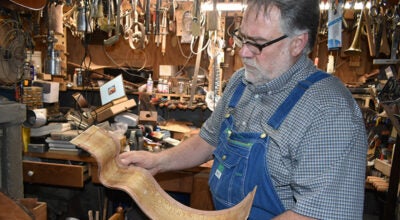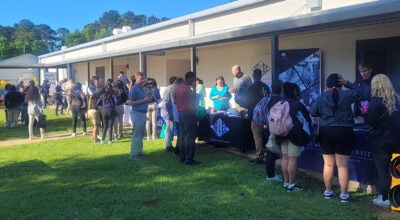Federal judge hears concerns on the proposed site of the consolidated high school
Published 5:32 pm Wednesday, December 14, 2022
|
Getting your Trinity Audio player ready...
|
One side of the G. W. Andrews Federal courtroom in Opelika was packed with concerned citizens of LaFayette Wednesday as they gathered before US District of Middle Alabama Judge Keith Watkins for a public hearing on the proposed location of the consolidated school.
Most citizens voiced concerns over mistreatment in the site selection process, unfair burden of transportation and claimed poor communication between the Chambers County School District and the public. In October, the CCSD announced that a new consolidated high school combining LaFayette High and Valley High will be built in Valley, pending court approval.
Watkins requested the hearing so that the public could voice its concerns.
“I’m here in a narrow role to ensure federal law is followed … It’s time that this issue was settled,” Watkins said.
Fifteen citizens spoke to the judge about their concerns, six of whom had requested to speak in advance. Twelve of the speakers were from the LaFayette community, though many more sat in the courtroom. All six members of the school board were present as well.
Many of those who spoke said that if LaFayette High’s students moved to Valley High, there would be discrimination and bullying among the kids. Yolanda Ratchford of LaFayette said that the CCSD has only offered temporary fixes.
“If they go to Valley High, there’s going to be internal segregation … We want a school that is fair, equitable and a place where all kids can thrive — not just Black kids or just White kids,” Ratchford said during the hearing.
Many citizens also voiced concerns about transportation for students. Nell Finley of LaFayette said that because her hometown is centrally located as the county seat, it would neutralize the transportation burden.
DAC Committee Member Alicia Perez-Purdue spoke on behalf of the committee to request the school board find a more centralized location for students living in the northern and western parts of the county.
Many community members stated that moving LaFayette High students to Valley High may result in White students leaving to go to a different school with better resources.
“When people have means, they have choices,” said LaFayette citizen Kalitha Reynolds.
Randall Williams of LaFayette referenced the private school, Chambers Academy, which was created after Chambers County Training School was closed. When Black students were moved to LaFayette High School, many White students transferred to Chambers Academy, Williams said.
“Within a few years, most White students were gone … All the places where Whites could remain in the majority, they stayed. Where they couldn’t, they created private schools,” Williams said.
LaFayette Mayor Kenneth Vines said that during a meeting review of sites from the two towns, the site selection committee left a lot of information blank on the land offered from LaFayette. He said he was told that either the superintendent couldn’t reach the landowners or they said they wouldn’t sell the land.
One of the landowners who offered his land for the site, Jeff Torbert, said at the hearing that he made agreements with landowner Barbara King to sell their land to the city. Torbert said that he never received a call from the CCSD Superintendent Casey Chambley.
“What really made me sick was the politics that became involved … I was told that he talked to me and Ms. King and that we weren’t interested in selling. I don’t remember the call,” Torbert said.
School Board members Jennifer Hunt and Victoria Leak also spoke in the latter half of the hearing. Both board members addressed concerns about transparency within the decision-making process. Hunt claimed that the Board of Education has offered full transparency of the analysis data to the public.
“We’re one of the few boards that still Facebook Live our board meetings … I don’t know how we could be more transparent,” Hunt said during the hearing.
In an Oct. 27 press release, the CCSD stated that they made their decision based on a site comparison analysis completed by a consulting firm, HOAR Property Management. During the hearing, CCSD Attorney Bob Meadows explained some of the factors that went into the analysis.
The analysis took into account the mileage burden on majority and minority students and found that Black students in the district would travel an average of 4,921 miles daily to the LaFayette site and 4,280.9 miles to the Valley site. Whereas, White students would travel an average of 5,311 miles daily to LaFayette and 2,135 miles to Valley.
Another factor in the analysis was that 67% of CCSD high school students live within the Valley school zone. Meadows said during the hearing that LaFayette High has a little over 200 students. Whereas, Valley High has over 600 students.
The analysis also compared the quality of each site with regard to transportation costs, sewage, electrical power, natural gas, water services, potential road improvement projections, environmental site and topographical surveys and property zoning requirements. The consultants also completed geotechnical surveys and wetland reports.
Before the hearing, the judge said he received around 150 written comments from the community, including the citizens who requested to speak.
During the hearing, Watkins also said that on Dec. 20 he plans to visit LaFayette and Valley High Schools as well as the two proposed sites.
In January, a court trial will be held to determine the resolution of the consolidated school location. Before the hearing, Watkins said that the eventual resolution may require compromises that leave both parties dissatisfied.
“Sometimes everybody’s unhappy, and that’s the best solution … There’s not much middle ground,” Watkins said. “I’m just not going to be able to make everyone happy.”
Watkins also said the resolution will comply with the federal law that the county can’t have a dual school system.
“As far as desegregation goes, we’ve made a lot of progress … We’re not at the end of this going to have a dual system because that’s the law,” Watkins said.



